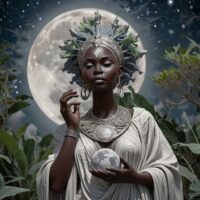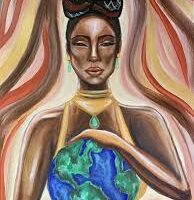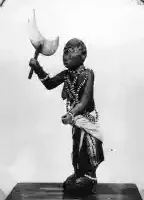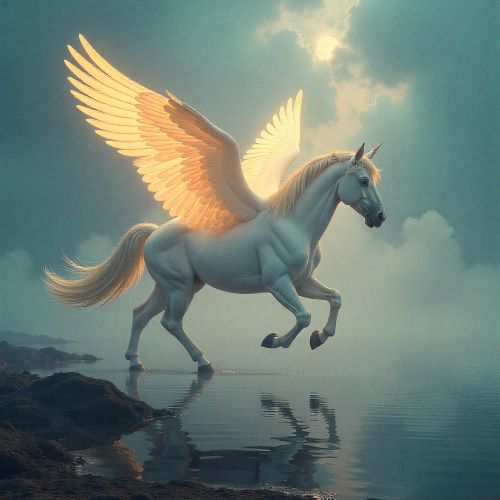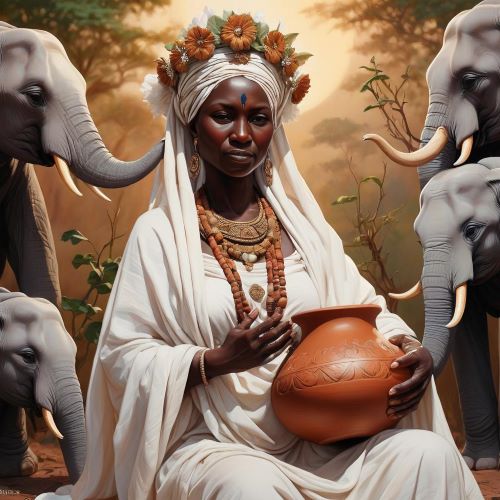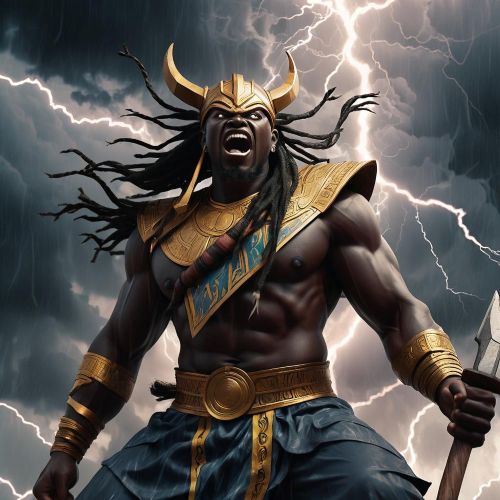Mawu : The Creator Goddess
Listen
At a glance
| Description | |
|---|---|
| Origin | Fon Mythology |
| Classification | Gods |
| Family Members | Nana Buluku (Mother), Lisa (Brother), Sakpata, Sogbo, Agbe, Age, Gu, Djo, Legba (Children) |
| Region | Benin, Ghana, Togo |
| Associated With | Creation, Moon, Fertility |
Mawu
Introduction
Mawu is a central figure in the spiritual traditions of West Africa, revered by the Fon people of Benin and the Ewe people of Ghana and Togo. She embodies the divine feminine and is closely linked with the moon, creation, fertility, and wisdom. Often paired with her male counterpart, Lisa, the two deities form the dual entity Mawu-Lisa, a balanced union representing the harmony of opposites—night and day, coolness and heat, female and male. As a creator goddess, Mawu holds a sacred place in cosmology and is credited with crafting the world and giving life to humanity. Her role has evolved through time, adapting to spiritual, cultural, and religious changes while maintaining her foundational presence in West African belief systems.
Physical Traits
Mawu is more symbolic than physically portrayed, embodying concepts like serenity, intuition, and life-giving force. She is often envisioned as an elderly woman, exuding grace and wisdom. The moon, coolness, and the west are all associated with her essence, reinforcing her role as a nurturing and restorative presence. Unlike Lisa, who represents the sun and vitality, Mawu’s traits lean toward reflection and preservation. In artistic interpretations and oral storytelling, she may be adorned in white or silver robes, echoing the tranquil light of the moon and the regenerative cycles she governs. Her symbolic nature makes her more a presence to be felt than an image to be seen.
Family
Mawu’s divine origins trace back to Nana Buluku, the primordial creator who birthed the universe and then withdrew, allowing Mawu and Lisa to shape and maintain the world. Mawu and Lisa together are not only twin deities but are often interpreted as two aspects of a single divine being. From their union emerged several offspring who each rule over specific elements of the cosmos.
These children, born in pairs, are known in Fon cosmology as powerful spirits or Vodun. They include Sakpata (earth and illness), Sogbo (thunder), Agbe (the sea), Age (forests and farming), Gu (war and metalwork), Djo (the winds), and Legba (the divine communicator and trickster). This divine lineage establishes Mawu not just as a creator, but also as the progenitor of a complex spiritual ecosystem where each force in nature has its own deity and realm.
Other names
Mawu is recognized by many names and honorifics that reflect her multifaceted divinity and widespread influence across cultures and languages. Among the Fon and Ewe people, she is simply called Mawu, often representing the highest form of divinity, while in her dual form with Lisa, she is known as Mawu-Lisa, symbolizing the harmonious union of feminine and masculine principles. Other notable variations include Mawu Sogbolisa (the all-powerful one), Mawu Kitikata (the eternal, unchanging deity), Mawu Adanuwotor (the creator of all things), and Yeye Mowo, her Yoruba counterpart associated with Obatala. Additional titles like Mawuga, Mawulolo, and Mawu nusewokatatɔ emphasize her greatness, omnipotence, and universal authority. These diverse names underscore both the reverence held for Mawu and the adaptability of her worship, especially as indigenous beliefs interacted and evolved alongside newer religious traditions.
Powers and Abilities
Mawu’s powers are deeply tied to her role as a life-giver and cosmic balancer. She is credited with molding humans from clay and giving them breath—a sacred act that underscores her role as the source of life. Her governance extends to the elements of nature, including water, the moon, and the fertility of the land.
Her influence over lunar cycles is especially significant. These cycles not only govern tides and agriculture but also symbolize the rhythms of life, death, and rebirth. Mawu is also responsible for setting the laws of nature and assigning roles to her divine children, ensuring that balance and order are preserved.
According to myth, Mawu placed a great serpent, Aido Hwedo, beneath the Earth to support its weight, suggesting her concern for the Earth’s stability and structure. Her divine justice ensures harmony, correcting imbalances and nurturing what has been broken. She remains a guardian spirit, silently guiding the natural world and its inhabitants.
Modern Day Influence
Mawu’s spiritual legacy continues to shape religious, artistic, and cultural expressions in West Africa and beyond. In traditional Vodun practices of Benin and Togo, she is still invoked during rituals related to childbirth, agriculture, and spiritual purification. Aspects of her worship also appear in Haitian Vodou, where Mawu is syncretized with figures such as the Virgin Mary, representing purity and divine motherhood.
The broader message of Mawu-Lisa—the need for balance between opposing forces—has found renewed significance in today’s social and ecological movements. Feminist spirituality often invokes Mawu as a divine feminine archetype, while environmental activists view her as a symbol of ecological equilibrium. Her teachings inspire a harmonious relationship with nature, emphasizing respect for all forms of life.
In the world of art and literature, Mawu continues to be a powerful muse. From traditional drumming and storytelling to contemporary galleries like the Mawu Art Gallery, which showcases African creativity and identity, her presence is palpable. Writers, musicians, and digital creators alike draw on her mythology to explore themes of ancestry, womanhood, and environmental consciousness.
Christianity’s spread has also led to an intertwining of beliefs. Mawu is sometimes equated with the Christian God in local interpretations, blending indigenous spirituality with imported religion. This syncretism helps retain traditional values while embracing new religious frameworks.
Related Images
Source
“Mawu – Wikipedia”. (n.d.). Retrieved from https://en.wikipedia.org/wiki/Mawu
“Fon creation myth – Wikipedia”. (2010, July 23). Retrieved from https://en.wikipedia.org/wiki/Fon_creation_myth
“The Cosmic Harmony of Mawu-Lisa: Guardians of Balance in …”. (2023, September 16). Retrieved from https://medium.com/@kwabena.ankrah10/the-cosmic-harmony-of-mawu-lisa-guardians-of-balance-in-african-tradition-e0d9858ab429
Ewe Mythology – Mythosphere. (2018, April 19). Retrieved from https://www.folklore.earth/culture/ewe/
“Mawu – The Paganista”. (2025, June 19). Retrieved from https://www.thepaganista.com/blog/mawu
“Ewe and Fon – Religion and Expressive Culture”. (2008, January 1). Retrieved from https://www.everyculture.com/Africa-Middle-East/Ewe-and-Fon-Religion-and-Expressive-Culture.html
“Mawu | Meaning & Significance | Goddess Oracle Deck”. (2025, June 26). Retrieved from https://www.aboutmybrain.com/cards/goddesses-of-the-world-oracle-deck/mawu
Frequently Asked Questions
What is lorem Ipsum?
I am text block. Click edit button to change this text. Lorem ipsum dolor sit amet, consectetur adipiscing elit. Ut elit tellus, luctus nec ullamcorper mattis, pulvinar dapibus leo.
What is lorem Ipsum?
I am text block. Click edit button to change this text. Lorem ipsum dolor sit amet, consectetur adipiscing elit. Ut elit tellus, luctus nec ullamcorper mattis, pulvinar dapibus leo.
What is lorem Ipsum?
I am text block. Click edit button to change this text. Lorem ipsum dolor sit amet, consectetur adipiscing elit. Ut elit tellus, luctus nec ullamcorper mattis, pulvinar dapibus leo.
What is lorem Ipsum?
I am text block. Click edit button to change this text. Lorem ipsum dolor sit amet, consectetur adipiscing elit. Ut elit tellus, luctus nec ullamcorper mattis, pulvinar dapibus leo.
What is lorem Ipsum?
I am text block. Click edit button to change this text. Lorem ipsum dolor sit amet, consectetur adipiscing elit. Ut elit tellus, luctus nec ullamcorper mattis, pulvinar dapibus leo.


